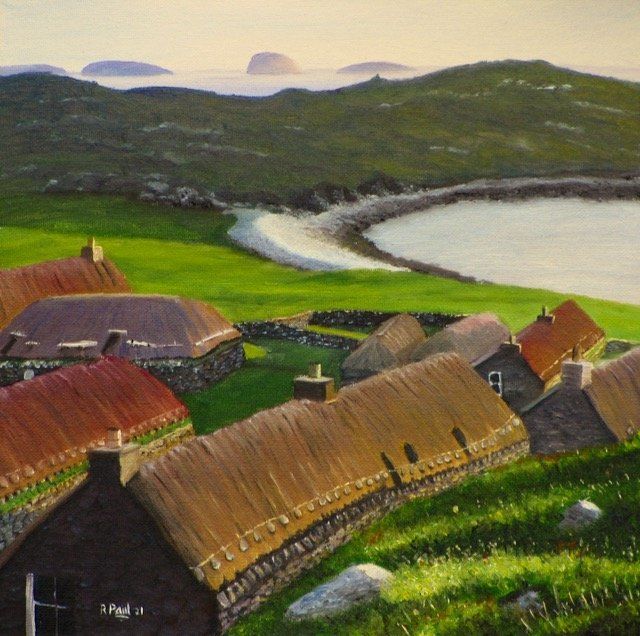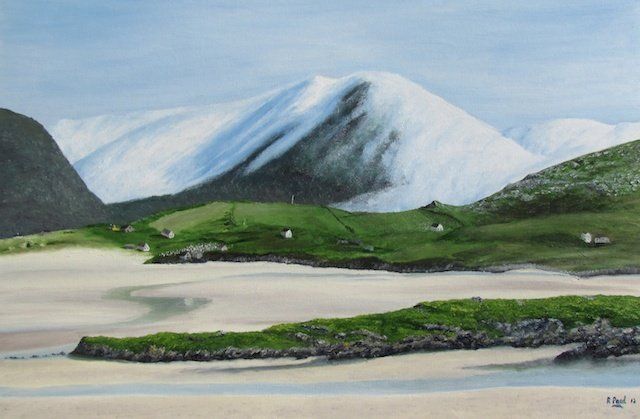Outer Hebrides
Tolsta not to your liking? Well lets take the circular bus journey from Stornoway, calling at the Callanish standing stones. A stop before that and we arrive at the blackhouse village, where its possible to stay the night. With the low sun lending a golden glow to the scene, that seems like a good option. The building in the foreground was a hostel ran by the Gatliff Trust. You'll need to check its status now, but you can always wildcamp outside the village.
... buy the print from Redbubble.com
Back to Stornoway now. There is much to explore, including the grounds of Lews Castle. If the midges chase us back we can take refuge at the woodland centre and enjoy a baked potato topped with South Uist hot smoked salmon - which is absolutely delicious.
We could stop the night, but instead a minibus has been laid on to takes us South through the evening to Tarbert. We don't stop there either, but continue over a pass to a spectacular view of the sun setting over a pure blue sea fringed with pale sand and wild meadows (known as machair here). As the tents are pitched by the shore, the twilight just keeps getting better and better, until midnight when the last of the glow finally subsides.

Heading away from the beaches we try our luck inland. It wouldn't take much to cross the island at this point, but we stop when we get to the top of the low hills, and take a look back. The previously rich colours of the shore now look subdued, and its closer moorland that now glows with a rich brown hue.

We spend the day exploring beaches, then settle down to a comfortable night in Leverburgh. We could take the bus to Rodel church, and on up the rocky East coast, but that is quite an experience. The road bends up, down, left and right in random order every few yards. The journey takes an hour and leaves you with a feeling that your stomach will never settle again.
So instead we opt for the ferry past numerous rocky and grassy little islands that fill the Sound Of Harris. Nowadays it docks at Berneray where we can either explore the island, or take the causeway to North Uist. The island is beautiful, with cottages and fields on the East side, and a vast grassland on the West leading to a pristine white beach. But be warned, the grassland is the nesting site of gulls, and they don't like visitors much.
Crossing the causeway, we come to another of the beaches backed by a fringe of grass and pasture. There is a low hill to climb between us and the rest of the island, and from the top we get a panoramic view of the causeway and the Sound of Harris, complete with moody cloud. But we are in sun for now, with a whole new island to explore.
We take careful note of the terrain for the descent. As the ground flattens we enter a maze of land and water - about 50% of each. It look like one of those Escher pictures where one thing transforms into the opposite.
We make it safely to the road, and along the way stop to admire one of the ponds. Its filled with waterlilies just coming into bloom. And we are surrounded by silence save for the croaking call of the elusive corncrake.
... buy the print from Redbubble.com
From North Uist the ever quieter road takes us down over Benbecula and down through South Uist, with machair and beach on the right, and bog and peaks on the left. Along the road side yellow flag irises shed the drops of rain off their glossy petals and waxy leaves.
There is another ferry ahead - this time across to Barra and Vatersay, the Southernmost inhabited islands (there are another four uninhabited ones). After a tour round we could leave by ferry for Oban, or take the flight to Glasgow. Its a tiny plane and the airport isn't much bigger - little more than a cafe with a small lounge for departure, and a bus shelter that doubles as baggage reclaim. The plane lands on the vast beach and bounces a little across the sand as it draws close. So how would you like to get back?







